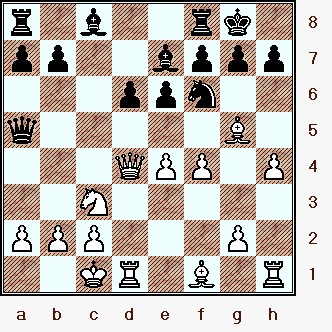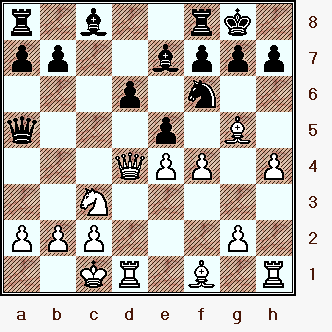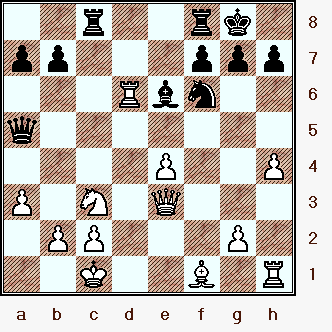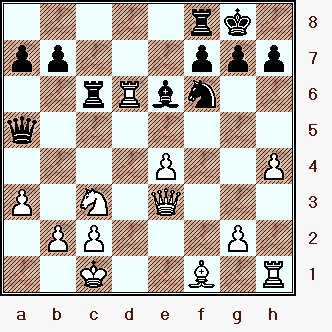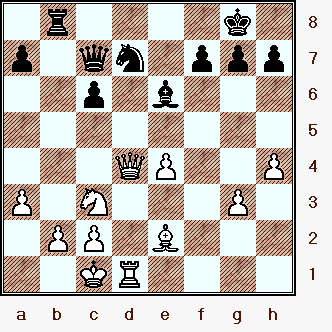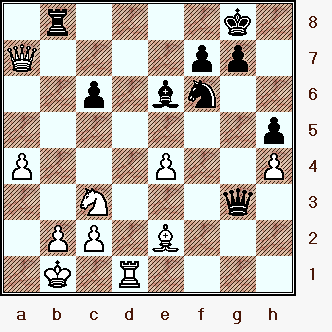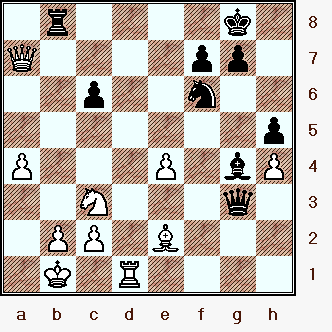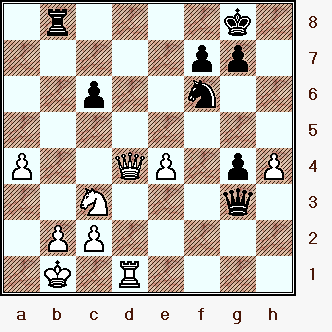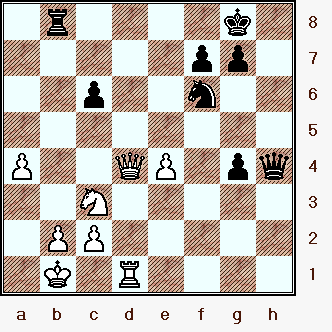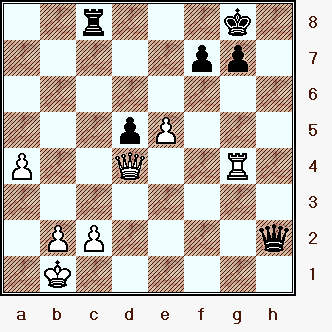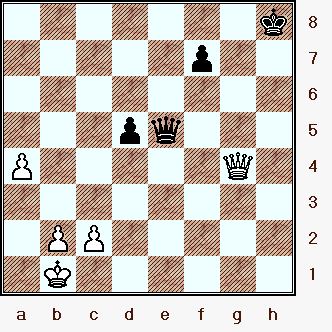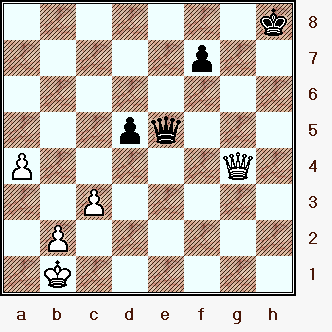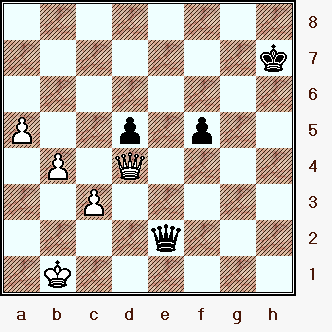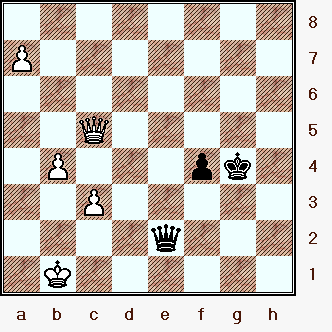GM
V. Topalov (2801) - GM
L. Nisipeanu (2693)
|
|
|
[A.J. Goldsby I]
My "Game of The Month" for the period for April, 2006. (Refer to TWIC # 596.)
This was the last - and possibly the best - game of the recent match between Topalov and Nisipeanu. It starts off as a topical Sicilian, and a tough middlegame translates into a wonderful Q+P ending ... that is played by the champ with real elan.
** ** ** ** ** ** ** ** ** ** ** ** ** ** ** ** ** ** ** ** ** ** ** ** ** ** ** ** ** ** ** ** ** ** ** **
{The ratings are those of FIDE and were already assigned to this game when I downloaded it from the TWIC website.
For more details on ratings, see the
FIDE rating list for 04/2006.}
1.e4 c5;
Was Nisipeanu trying to catch his opponent off guard? (Lately, Black has not been using the Sicilian, but has opted for other weapons. See my column for January, 2005 - for one example.)
2.Nf3 d6;
3.d4 cxd4; 4.Nxd4 Nf6; 5.Nc3 Nc6;
A standard "Open Sicilian" position, White has open lines and slightly more play.
[See MCO-14, beginning on page # 317 ...
for a discussion, and some of the many lines that can arise from the current board position.]
I have already covered the Sicilian many times before, see the page that lists all of the games for this column - for more details.
[ The move 5...a6; leads to the ever-popular Najdorf.
For a relatively recent contest, between two top GM's, see the game:
GM A. Shirov - GM V.
Bologan; /
ICT, 7th Karpov {Master's, Inv.}
Poikovsky,
RUS; 2006. (1-0,
31 m.)
{White won a very nice game in only thirty-one moves.}
]
6.Bg5 e6;
7.Qd2 Be7;
8.0-0-0 0-0; 9.f4 Nxd4;
10.Qxd4 Qa5;
Thus far, we have a position from "The Richter-Rauzer System,"
which is currently a fairly popular continuation for White.
11.h4!?,
(Mind games?!?)
{See the diagram given -
just below.}
An interesting move ... with its own brand of poison.
(A lower-rated player might jump at the opportunity to play 11...h6; but this could lead to the opening of the h-file and a rapid mate.)
|
|
r1b2rk1/pp2bppp/3ppn2/q5B1/3QPP1P/2N5/PPP3P1/2KR1B1R b
Is Topalov engaging in a bit of psychology here? You see, according to the database, his opponent first played 11.h4!? vs. Tyomkin in the European Under-20 Championships in 1995, (and lost). Certainly White's choice of moves here are interesting.
GM Marin says that Topalov was "unaware" of the psychological ramifications of this move, yet - I find that hard to believe. (Is he seriously suggesting that Topalov did not look at any of the games in the database {by his opponent} while preparing for this match?)
[ The main line would probably be: 11.Bc4 Bd7; 12.e5!?, {Diag?}
An indicated Pawn break, although White could play other moves, (like 12.Bb3); here.( Or 12.Bb3 Bc6; 13.Rhe1, "+/=" (White has a small advantage in this position.)
See MCO-14, page # 319, and column # 02 for more on the variations with 12.Bb3.)12...dxe5; 13.Qxe5!?, A newer move - in this position.
(This was recommended in a recent book on this system, and also in a NIC openings survey.)*** *** *** *** *** *** *** *** *** *** *** *** *** *** *** *** *** *** *** ***
( The first player gets a time-tested edge after the following moves:
(>/=) 13.fxe5, ('!') 13...Bc6; 14.Bd2 Nd7; 15.Nd5 Qd8; 16.Nxe7+ Qxe7;
The end of the column.17.Rhe1 Rfd8; 18.Qg4, '±'
when White has a very solid advantage here. (Black will usually sack the exchange
in this line, see MCO for more details.)GM V. Ivanchuk - GM V. Anand; / The Seventh (7th) Match Game
Linares, ESP; 1992. (1-0, 51 m.) {White won in fifty-one total moves.}[ See MCO-14, page # 319; column # 01 and all associated notes for this column.
Especially see note # (e.) at the bottom of that page. ] )*** *** *** *** *** *** *** *** *** *** *** *** *** *** *** *** *** *** *** ***
13...Qb6!?; "~" (Maybe "+/=")
Black has a fairly playable set-up in this position, and drew the game without any great difficulty.GM Anatoly Karpov (2780) - GM Gata Kamsky (2695); / Sicilian Theme Tournament (R1)
Buenos Aires, ARG; 1994. {A draw was agreed after 26 fairly solid moves.} ]
11...e5!?;
hmmm (Searching for ...) {See
the diagram given - just below.}
Black strikes back in the center, although a slower attempt, (like with 11...a6 or 11...Rd8); might have been the wisest course for Nisipeanu from this position.
|
|
r1b2rk1/pp2bppp/3p1n2/q3p1B1/3QPP1P/2N5/PPP3P1/2KR1B1R w
A quick look at the chess board will show that one of the drawbacks of 11...e5; is that the d5-point has been left wide open for Topalov's
pieces.
I am currently reading a good book, "Secrets of Positional Chess," by GM Dražen Marović. In this volume, the very first chapter starts off with games where Black weakened the d5-square in the Sicilian ... & loses!! However, to be fair, Nisipeanu has a reputation for playing chess with a fighting and uncompromising style, so such moves are probably typical for him.
[ Fritz likes:
11...h6;
here, but the consequences of this move could be well
beyond the box's ability to see, (in all lines).
For 11...h6; see the contest:
GM S. Dvoirys - GM K. Aseev; /
The 57th U.R.S. Championships;
Leningrad, USSR; 1990.
(1-0)
{White won a nice game in a grand total of 44 wild moves.} ]
White's next move is sensible enough, but appears to be new to master praxis.
12.Qe3N exf4;
Black decides to capture, although the move of 12...Be6 was also to be considered here.
(Apparently Black has already made the decision to gambit a Pawn for play.)
13.Bxf4 Be6; 14.Bxd6 Bxd6;
15.Rxd6 Rac8; (...Rfc8!?)
16.a3[],
{See the diagram given,
just below here.}
White's last move was forced, just about every other try would have lost material. (E.g., b3? QxN/c3.)
|
|
2r2rk1/pp3ppp/3Rbn2/q7/4P2P/P1N1Q3/1PP3P1/2K2B1R b
Time to take stock, which side of the board would you rather play?
[Black has a fair amount of play ("comp") for the lost pawn.]
[ But White should NOT play:
</= 16.Kb1? Rxc3!; 17.bxc3,
{D?}
Forced - according to Fritz.
( Even worse would be:
</= 17.Qxc3? Qxa2+; 18.Kc1 Qa1+;
19.Kd2 Nxe4+; ("-/+")
with a 'family fork' here. )
17...Qxa2+; 18.Kc1 Qa3+; "-/+" and White drops the Rook/d6. ]
16...Rc6!?;
{See the diagram given - just
below.}
I am not sure that I understand this move.
(The box suggests 16...Ng4!? here, which might be worthy of some serious investigation.)
|
|
5rk1/pp3ppp/2rRbn2/q7/4P2P/P1N1Q3/1PP3P1/2K2B1R w
Maybe - after some time of analysis - I have identified exactly where Black went wrong in this contest.
(Certainly, this is a key moment in this struggle.)
[ Maybe GM L. Nisipeanu had to try a continuation something like:
(>/=) 16...Rxc3; 17.Qxc3
Qxc3; 18.bxc3 Nxe4; 19.Rd4 Nxc3;
"~"
when Black would have had some chances to draw this ending.
]
Now White tries to slowly improve his position.
17.Rxc6 bxc6;
18.Be2 Nd7; 19.Rd1 Qc7; 20.g3 Rb8; 21.Qd4!?,
(non-committal)
{See the diagram given - just below.}
Topalov makes a move that is either just average ... or so deep ('!!')
that it is beyond the computer's ability to "scope it out" in all the
various lines and sub-variations.
|
|
1r4k1/p1qn1ppp/2p1b3/8/3QP2P/P1N3P1/1PP1B3/2KR4 b
Is Topalov trying to tempt his fiery opponent into trading down into an inferior ending?
[ The machine prefers the play of
21.g4,
"+/=" (Maybe - '±')
and this seems to make a certain amount of sense here.
***************************************************
A completely different method would have been to play a line
something like:
21.Rd4!? Ne5; 22.Na4,
"+/=" {D?}
when White has a small edge. ]
21...Qxg3;
22.Qxa7 Nf6;
23.Kb1 h5!?; (Maybe dubious?)
Black had to play something here, but maybe 23...h6 or 23...Qe5 were a little more prudent than what L.D. Nisipeanu actually chose here.
24.a4,
(Push the passed pawn!)
{See the diagram given - just below.}
As this foot-soldier is the obvious candidate for promotion, advancing him looks like the correct thing for Topalov to do.
|
|
1r4k1/Q4pp1/2p1bn2/7p/P3P2P/2N3q1/1PP1B3/1K1R4 b
This would be a good time to take a hard, long look at the position, and try to figure out exactly what is happening here.
[ Maybe 24.Qc5 Qxh4; 25.Qd6, '±' was a sharper line here? ]
24...Bg4?!; (Hmmm.)
{See the diagram
given - just below here.}
This looks like the wrong idea ... just based on general considerations.
(Most of the time, the player who is behind on material should avoid trading pieces - as this will usually lead to a lost endgame.)
|
|
1r4k1/Q4pp1/2p2n2/7p/P3P1bP/2N3q1/1PP1B3/1K1R4 w
Black had a good concept, I think his idea was that a trade would give him a monster of a passed pawn.
(But Topalov is fearless here!)
[ Maybe >/= 24...Qe5!?; was best? ]
25.Bxg4! hxg4; 26.Qd4!, {See
the diagram given - just below.}
This is good, as was Qc5.
|
|
1r4k1/5pp1/2p2n2/8/P2QP1pP/2N3q1/1PP5/1K1R4 b
Recentralizing the most powerful piece is not only wise, it makes for a good (chess) picture as well.
[ Less effective was:
</=
26.a5!? Qe5; 27.Kc1 g3; "<=>" when Black gets good counterplay.
(Maybe "=/+" or even "/+") ]
26...Qxh4?;
(Urgh, gasp, cough!) {See
the diagram given - just below.}
This is almost certainly the losing move ... and it causes a radical shift in most program's evaluation of the position.
|
|
1r4k1/5pp1/2p2n2/8/P2QP1pq/2N5/1PP5/1K1R4 w
Nisipeanu took a long time over his last few moves, and might have been of the verge of panic. In such situations, its easy to allow your
emotions to get the better of you. (You feel you have to do something, and do it fast - or lose.)
[ Black had to (instead) try:
>/=
26...Re8[]; 27.a5, "+/="
27...Qc7;
"<=>"
with chances to defend. (However slim they might be.)
]
27.e5 Nd5;
28.Nxd5 cxd5;
29.Rg1, (A solid, practical idea.)
Topalov decides to immediately eliminate his opponent's most dangerous button.
[ Fritz gives - instead - the line of:
>/= 29.Qxd5!
Qe7; 30.Qe4 Qe6; 31.Qf4! Re8; 32.b4
Qxe5!?; 33.Qxg4, "+/-"
33...g5;
but I think many humans would be reluctant to play in this fashion. (The position with Q+R
and the reduced pawns appear to be a little
scary, and give Black a ton of play here.) ]
29...Qh2!?,
Nisipeanu appears to be reduced to playing for cheap tricks.
[ In any case, the position with:
29...Rc8; 30.Qxg4 Qxg4;
31.Rxg4, '±' (Maybe "+/-")
{D?}
seems to only offer Black ... a dead lost R+P endgame!
]
30.Rxg4 Rc8;
(Survey says ...)
{See
the diagram given - just below.}
Black threatens a capture on c2.
|
|
2r3k1/5pp1/8/3pP3/P2Q2R1/8/1PP4q/1K6 w
At first, I thought that this was an error. Yet after spending many hours on this game, and scrutinizing it with several different programs, it transpires that: A.) Black is quite lost; and B.) That Nisipeanu did not have any move - here - that was better.
Now its almost a chess problem, with White to move and win. Can you discover the winning shot here?
31.Rxg7+! Kh8;
It really does not matter now.
[ Or Black could have tried:
31...Kxg7; 32.Qg4+ Kh7;
33.Qxc8 Qxe5; 34.Qc5, "+/-"
and White's passed a-pawn will fly up to the promotion square.
]
Topalov took a lot of time - about fifteen minutes - on his next move.
32.Rg4! Rc4;
Okey-dokey .......
Believe it or not, this is the first (move) choice for Fritz here.
[ Win or lose, I would have tried (>/=) 32...Qxc2+; in this position ... as Black. ]
33.Qd1 Rxg4;
34.Qxg4 Qxe5; {See the diagram given -
just below.}
Black (appears) to have gained a measure of both counterplay ... and some drawing chances in this Queen-and-Pawn ending.
|
|
7k/5p2/8/3pq3/P5Q1/8/1PP5/1K6 w
Now Topalov shows that he is no slouch in the final phase of the game, and brings home the full point with some nice technique.
****************************************
Begin Q+P endgame phase.
****************************************
35.c3,
('!' - GM M. Marin) {See
the diagram given - just below.}
Another solid decision ... that shows the champ has a good head on his shoulders.
|
|
7k/5p2/8/3pq3/P5Q1/2P5/1P6/1K6 b
In Q+P endings, concepts like central squares, anchor points, king safety, passed Pawns and piece activity are important. Other considerations, like the material balance and pawn structure ... take a back seat.
[
The iron monster suggests the following continuation:
(>/=)
35.Qh4+ Kg7; 36.a5 Qe6;
37.Qd4+ Kg8; 38.Qb6,
"+/-"
which is also winning for White. ]
35...Kh7;
36.Qd4! Qe6;
The K+P ending is dead lost for Black - thus he cannot swap the Queens in this position.
(And you do not have to be a GM to figure this one out.)
37.a5 f5!?;
38.b4!? Qe2; {See
the diagram given - just below.}
Black is doing the best he can here. (Nothing will save him.)
|
|
8/7k/8/P2p1p2/1P1Q4/2P5/4q3/1K6 w
One last look ... before the slaughter.
[ Or (</=) 38...Kg8!?; 39.Kb2 Kf8; 40.b5, "+/-" which also wins. ]
Now that Black has cut off the WK from the battle, Topalov has to do it all with his Queen and Pawns.
("No problem," says the champion. He manages quite nicely - and even makes winning this position look easy in the process.)
39.Qxd5 Kg6;
40.Qd6+ Kg5; 41.a6 f4; 42.Qc5+! Kg4; 43.a7,
"+/-" Black Resigns.
{See
the diagram given - in the box below.}
GM L.D. Nisipeanu does not want anyone to draw him a map. (He knows there this road is heading.)
|
|
8/P7/8/2Q5/1P3pk1/2P5/4q3/1K6 b
[ After the moves:
43.a7 Qe4+; 44.Kb2 Qg2+; 45.Ka3 Qb7; 46.Qa5 Qa8; 47.Qc7 f3;
48.Qb8 Qc6; 49.Qg8+ Kf4; 50.a8Q!!, {D?}
This appears to be the fastest win for White.( Or 50.Kb3!? "+/-")
50...Qxc3+, Hey! (Its what I would play.)
( Or 50...Qxa8+; 51.Qxa8 f2; 52.Qf8+ Ke3; 53.Qxf2+ Kxf2; 54.b5, "+/-"
is a simple K+P ending. )51.Ka4 Qc2+; 52.Qb3, "+/-" Black has run out of checks.
*******
( Fritz's line from here: 52.Qb3 Qxb3+; 53.Kxb3 f2; 54.Qg2, "+/-" with an easy win for White.
** ** ** ** ** ** ** ** ** ** ** ** ** ** ** ** ** ** ** ** ** ** ** ** ** ** ** ** ** **
To me, the most simple, 'human' continuation here would be:
52.Qb3 Qe2; 53.Qbxf3+!? Qxf3; 54.Qxf3+ Kxf3; 55.b5 Ke4; 56.b6 Kd5; 57.b7, "+/-"
with an obvious win. ) ]
An excellent Q+P endgame by the Champion. The aspiring student would do well to study this method!
(Set up this endgame and play it out versus a friend or a computer. If you cannot win it consistently in practice, you have no hope of
ever accomplishing a similar feat in the tense atmosphere of a tournament.)
Copyright (c) A.J. Goldsby, 2006. All rights reserved.
1 - 0
The analysis for this page was prepared with the excellent programs, ChessBase 8.0 and ChessBase 9.0.
The HTML was polished with several different tools and programs, (mostly FP) ... the text was checked for spelling with MS Word.
The diagrams were created with the program, Chess Captor 2.25.
This game is also annotated by GM M. Marin, (on the popular CB website); here.
